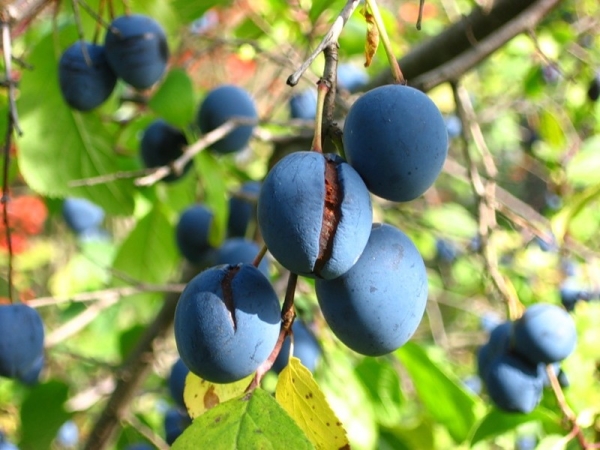Modest shrub from the kind of Plum - turn, does not bring any trouble during the cultivation and has a high value for the person.
The chemical composition of all parts of the plant became the basis for many drugs in traditional medicine and in folk therapy.
Jam, jam and fruit compote - a real decoration and pride of any table.
Table of contents
Biological description of the shrub thorns
Blackthorn (blackthorn) - Branched Thorny Shrub, reaching a height of 3.5 to 4, 5 m. Less often the plant can be found in the form of a tree up to 8 m in height.
Shrub habitat hillsides, ravines and forest edges of Central Asia, the Caucasus, the Mediterranean, Western Siberia and Europe.
It is assumed that the turn originated from cherry plum as a result of the modification of shrub tissues under the influence of gradual changes in the microclimate.
The turn has a high frost resistance. and is able to withstand low temperatures up to 40 ° C. Without much stress, the shrub is experiencing drought.
The turnip develops well on the soils of the Moscow region, which are not suitable for the cultivation of other crops, so it is often placed on the borders of the backyard, where the soil is saline.
The young branches of the shrub are covered with pubescent bark and form sharp spikes at the end.Leathery leaves are obovate, serrated and dark green in color. Located on short petioles and reach a length of 5 cm.
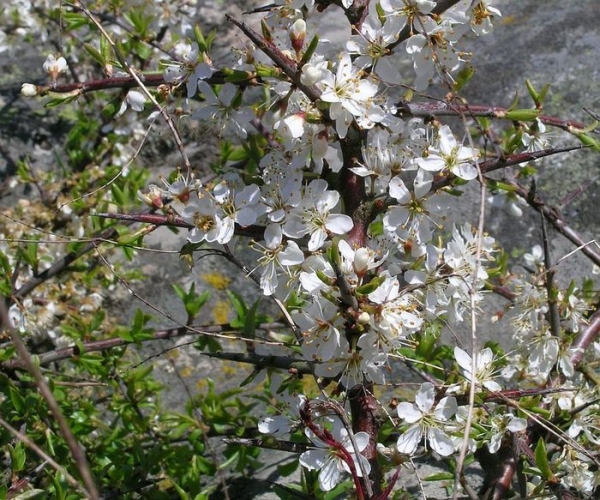
Before leafing thorns bloom profusely in the months of April and May. The flowers of the plant are small, white and arranged in pairs or singly on short peduncles.
During this period, the shrub looks like a big white ball, and the area around it is filled with the scent of almond.
Bush begins to bear in 2-3 years after planting. The fruit is single-ended, round in shape and small in size, up to 15 mm in diameter.
Under the thin black-and-blue skin there is a green flesh and an inseparable bone. The fruits ripen at the end of the summer and can hold out on the shrub throughout the winter.
The fruits of the bush have a tart-sour taste: This is due to the high content of tannins, which are neutralized after exposure to low temperature.
Fruiting is regular; 3-4 kg of fruits can be collected from one bush.
The turn is a self-sterile plant. and is not able to tie fruit from its own pollen. To ripen the fruit, the plant requires cross-pollination. It is mainly produced by bees.
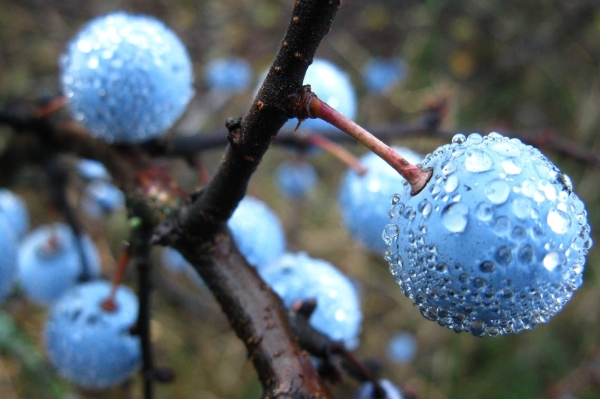
Ways to breed blackthorn
Shrubs multiply seeds, dividing the bush and root cuttings. Seeds are preferably sown in the fall immediately after separation from the pulp.
For spring sowing a proper long stratification on average 160 days is required. To do this, the bone is washed from the pulp, placed in layers of moss and cleaned in a cold place with a temperature of 0 ° C to + 5 ° C.
A month before planting, the temperature is reduced to -1 ° C. The bones are kept in a slightly moist environment.
About bone readiness for transplanting to the substrate can be judged by the cracks on the surface. For temporary development will need a capacity of at least 20-25 cm in diameter.
The optimal substrate for the development of seedlings consists of:
- sod soil 40%;
- humus 20%;
- lowland peat 20%;
- river sand 20%.
Further care of the seedling consists of regular watering, fertilizing 1 time a month with minerals.
Seedlings are transplanted to a permanent place at the age of two. The turn grown from the seed will bear fruit 4-5 years after planting.
Many gardeners prefer seed propagation for obtaining frost-resistant stocks for more capricious cultures.
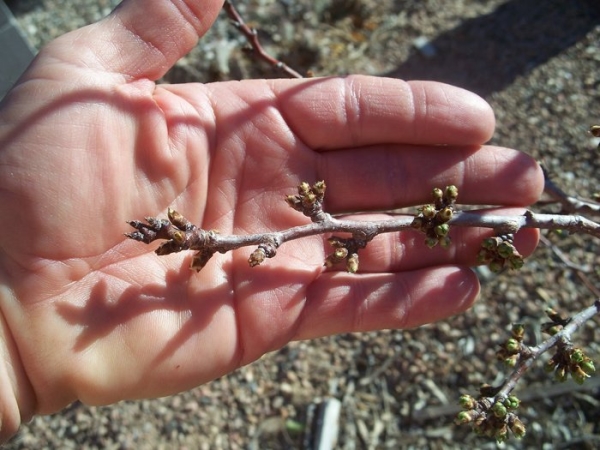
Young shoots are separated from the mother plant in autumnFor this, the connecting root is chopped. At the end of April, the separated shrub is transplanted to the designated site.
Plum variety Turn (Thorn) well propagated by rhizome division. To do this, it is necessary to dig up the roots in the autumn at a distance of 1 to 1.5 m from the trunk. Good planting material is a root with an average thickness of 1.5 cm and a length of 15 cm.
In late April, the cuttings are transplanted into the soil (sand, peat 1: 3) under the film. They are placed at a distance of 5 cm vertically under a slight slope.
The upper ends should remain at a depth of 2 cm.after which the surface of the soil is mulched with sawdust.Root cuttings should be provided with regular watering and 3-4 dressings per season, mainly with nitrogen fertilizers.
Next fall, the plant is transplanted into a temporary ground., similar to when planting pits and grow up to 1 m, after which they are transplanted into the personal plot.
Shrub care
Characteristic of thorns absolute simplicity to growing conditions. On the contrary, excessive care and constant feeding of the shrub lead to abundant growth and suppression of neighboring plants.
For planting thorns, a well-lit or partly shade area is preferred. The soil should be drained with moisture and neutral acidity. The optimal distance between the bushes is at least 2 m.
In March, rejuvenating pruning is carried out., removing damaged and rotten branches. Ideally, if there are 3-4 skeletal branches on the shrub.
This will significantly improve the quality and quantity of the crop, protect the shrub from strong crown thickening.
Water the turn only in very dry weather.To improve the quality of fruits and the formation of new shoots during flowering, organic matter is introduced into the tree trunk: compost or rotted manure. Winter shelter is not required.
The benefits and harms of the fruit are divers
The beneficial properties of the fruit of the shrub determines special chemical compositionwhich focus:
- glucose, fructose;
- organic matter;
- mineral salts;
- vitamins A, E, C, P;
- coumarins;
- steroids;
- nitrogen compounds;
- essential oils;
- pectins;
- tannins.

Thorn fruits especially valuable for the gastrointestinal tract. With constant use of thorns, the microflora balance is restored, the attacks of gastritis and colitis are reduced. Due to diuretic properties, slags and toxins are removed from the body.
Thorn fruits have antiparasitic effects on the simplest organisms. This contributes to the normalization of intestinal motility, which improves the digestion of food and activates the metabolism.
Especially valuable are thorns with a high content of vitamin R. This is a flavonoid, which includes more than 120 beneficial substances for the body.
The constant intake of these substances in the body normalizes blood pressure, reduces the permeability of blood vessels, balances the heart rhythm.
Under their influence stimulates the work of the adrenal cortex - It is an important factor for the balance of hormonal levels.
Additionally, the fruit will absorb all the unpleasant odors from the mouth. The only drawback, the coloring properties of fruitA persistent bluish tint will last several days.
Thorns are not recommended to be consumed when acute forms of gastrointestinal diseases, especially for bleeding. It is undesirable to use for people with increased gastric acidity and hypotension.
The bones of the fruit tend to accumulate amygdalin substance. It at high concentrations has a toxic effect on the body. Therefore recommended jam and stewed fruit with stones to store no more than a year.
The use of prickly thorn in traditional medicine
It is proved that medicines from different parts of the shrub have a therapeutic effect on the body:
- antipyretic;
- anti-inflammatory;
- antibacterial;
- diuretic;
- astringent;
- expectorant;
- sudorific.
These properties are thorns. actively used in traditional and traditional medicine, for the general and symptomatic treatment of serious pathologies.
Flowers: when to collect
The medicinal ingredient is harvested before opening the buds.. Infusions and decoctions of flowers treat hypertension, constipation, liver disease, prostate adenoma, rheumatism and atherosclerosis.
Flower-based drugs have a diuretic, diaphoretic and sedative effect.
Preparation of medicines:
- Infusion. Crushed flowers (2 tsp) are poured with cold water (250 ml) and infused for 8 hours. Take the tool in 2 tbsp. l 4 times a day as a diuretic and diaphoretic in case of kidney and liver diseases.
- Decoction. Medical raw materials (2 hours) are poured with water (250 ml) and slowly brought to a boil. Take 100 ml 2 times a day. Broth is used as an adjunct in the treatment of vascular diseases.
Thorn flower-based medicines have a strong antimicrobial effect and will useful for treating skin diseases. To do this, the problem areas are wiped with a cotton pad,soaked in broth or infusion in the morning and evening.
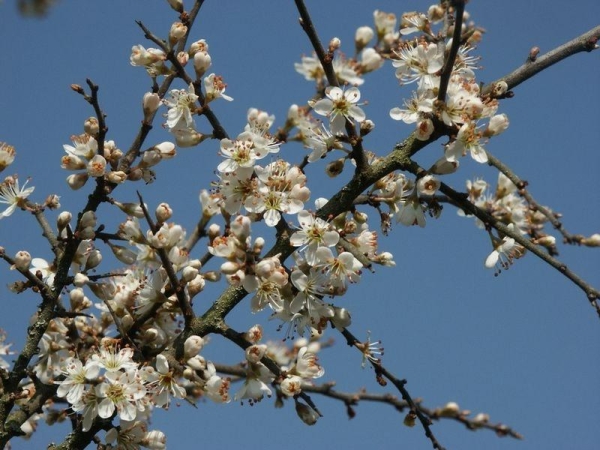
Root: proper preparation
Thorn roots are harvested in autumn. In order not to harm the shrub, the medicinal ingredient is dug out at a distance of 1-1.5 m from the trunk. After that, they are thoroughly washed and dried at a temperature of + 60 ° C.
Broth from thorns has antipyretic, diaphoretic and anti-inflammatory effects. It is used for colds and to cleanse the body of toxins.
For the treatment of whiter spend douching, and for skin inflammation lotions with the drug.
For cooking broth crushed raw material (10 g) is poured with cold water (500 ml) and boiled on low heat for 15 minutes. Take 100 ml 3 times a day. For douching, the drug is diluted with water 1: 1.
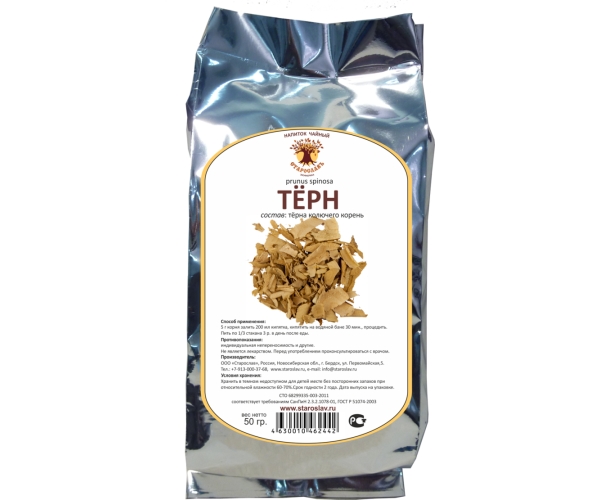
Bark
The bark is harvested from the bushes to be cut down and before the plant blooms.. After that, washed and dried as well as the roots.
Used as a remedy for blood purification, treatment of female inflammatory diseases,furuncle and erysipelas on the skin.
For cooking broth need crushed bark (1 teaspoon). Pour with water (250 ml) and boil for 15 minutes. Take 100 ml 3 times a day. For douching diluted with water 1: 1.
Fruit
The thorns are harvested in the second decade of October.. After that, they must be dried for a week, if possible in the open air or in a furnace at low temperature.
Preparation of medicines:
- Infusion. The ground ingredient (1 tablespoon) is filled with boiling water (250 ml), infused for 1 hour. For the treatment of gastrointestinal disorders take 100 ml before breakfast for 4 days.
- The juice. Fruits are peeled and heated to 70 ° C. After that, they are kneaded and squeezed out. Apply with giardiasis, eating disorders and colds.
The juice of the thorns has a fixing effect and will be useful in diarrhea.

The use of plum Thorn in cooking
The fruits of the shrub are rarely consumed fresh. But various jams and jams of them have a spicy taste and are popular with children and adults.
Jam
Ingredients:
- fruit thorns 2.5 kg;
- sugar 3 kg;
- water 1 l.
Sorted and washed fruits simmer for 15 minutes. Throw back in a colander and remove the bones. Peeled fruits spread in the former decoction and add sugar.
After the sugar has completely dissolved, it is necessary to boil the jam for 15 minutes. For storage the product is bottled in sterilized jars.
Turnip Jam:
Jam
Ingredients:
- fruit thorns 1 kg;
- sugar 1 kg;
- water 100 ml.
Washed and pitted fruits pour water and boil for 30 minutes over low heat. After that, you need to rub the berries through a sieve. Place the mass in a container, add water, sugar and cook for 30 minutes.
About the readiness of the jam can be judged by the thickness of the product. Cooked jam is poured into sterilized jars.
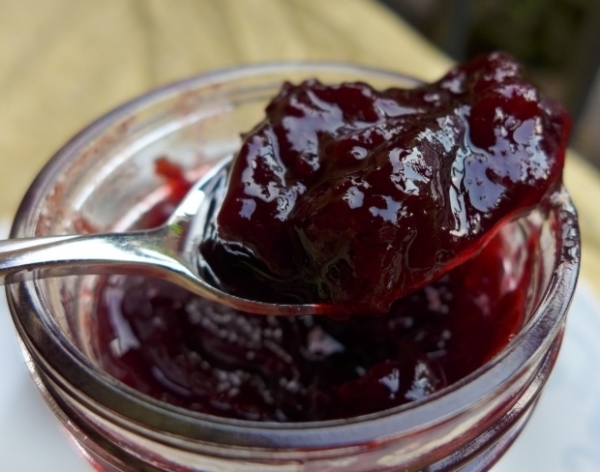
Compote
Ingredients:
- fruit thorns 1 kg;
- sugar syrup 50%.
Washed fruits are laid out in boiling syrup and cook 5 minutes. After that, the fruits are laid in jars and filled with syrup.
Capped lids are placed in a container with water and boiled at 75 ° C for 15 minutes and sealed with lids. At the time of cooling banks compote turn his throat down.
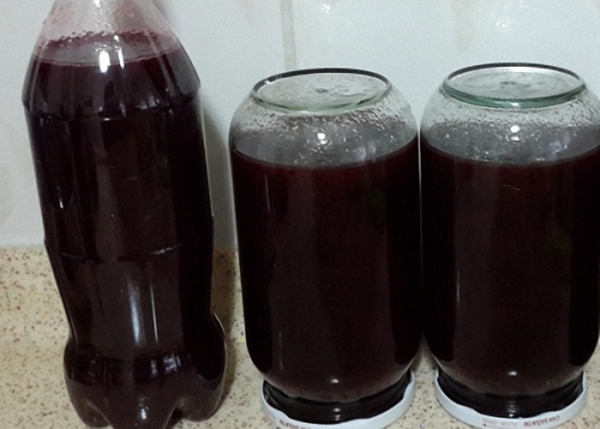
Wine
Ingredients:
- fruit thorns 10 kg;
- sugar 3 kg;
- water 10 liters.
Slightly frost-bitten fruit lures 2 days. After that, the berries are kneaded, placed in a container with bones, filled with water.
300 g of sugar is added to each liter of raw material received., mixed and bottled. After 30-45 days, the precipitate of wine is separated and poured into new containers.
Wine of thorns:
Tea
For adding to tea or self steaming harvest the leaves and thorns. To do this, they need to be dried and packed in paper bags.
Many mistresses Dried and chopped blackthorn fruits are added to teawhich make the drink not only useful, but also fragrant.
In the recent past, the cultivation of thorns has been practiced everywhere.Despite the absolute practicality and economic benefits of the cultivation of the shrub unfairly pushed aside.
However, the mass use of shrubs as a raw material for drugs only grows and every year leads to a greater shortage of the source of useful ingredients.
Thus, we can conclude that growing thorns is beneficial and beneficial not only within the garden plotbut also a great option for business.
